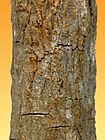Note: This is a project under development. The articles on this wiki are just being initiated and broadly incomplete. You can Help creating new pages.
Difference between revisions of "Cinchona officinalis"
| Line 1: | Line 1: | ||
[[File:Cinchona officinalis 001.JPG|thumb|right]] | [[File:Cinchona officinalis 001.JPG|thumb|right]] | ||
| + | Lojabark is an evergreen shrub or small tree that can grow 6 - 20 metres tall. The plant has long been used medicinally by the native people of S. America to treat fevers and a range of other conditions. | ||
==Uses== | ==Uses== | ||
| − | {{Uses|}}, {{Uses|}}, {{Uses|}}, {{Uses|}}, {{Uses|}}, {{Uses|}}, {{Uses| | + | {{Uses|Fevers}}, {{Uses|Malaria}}, {{Uses|Neuralgia}}, {{Uses|Muscle cramps}}, {{Uses|Cardiac fibrillation}}, {{Uses|Drunkenness}}, {{Uses|Sore throats}}. |
==Parts Used== | ==Parts Used== | ||
| Line 28: | Line 29: | ||
==Habit== | ==Habit== | ||
| − | {{Habit|}} | + | {{Habit|Evergreen tree}} |
==Identification== | ==Identification== | ||
| Line 47: | Line 48: | ||
==Mode of Propagation== | ==Mode of Propagation== | ||
| − | {{Propagation|}} | + | {{Propagation|Seeds}}, {{Propagation|Nodal softwood cuttings}}, {{Propagation|Cuttings of half-ripe wood}}. |
==How to plant/cultivate== | ==How to plant/cultivate== | ||
| − | <ref name="How to plant/cultivate"/> | + | A plant of the moist tropics, where it is found at elevations from 1,500 - 3,000 metres.<ref name="How to plant/cultivate"/> |
==Commonly seen growing in areas== | ==Commonly seen growing in areas== | ||
| − | {{Commonly seen|}}, {{Commonly seen|}}, {{Commonly seen| | + | {{Commonly seen|Cool areas}}, {{Commonly seen|Humid areas}}, {{Commonly seen|Mountain regions}}. |
==Photo Gallery== | ==Photo Gallery== | ||
| Line 66: | Line 67: | ||
==References== | ==References== | ||
<references> | <references> | ||
| + | <ref name="chemical composition">[Chemistry]</ref> | ||
| + | <ref name="Leaf">[Morphology]</ref> | ||
| + | <ref name="How to plant/cultivate">[http://tropical.theferns.info/viewtropical.php?id=Cinchona+officinalis Cultivation]</ref> | ||
| − | |||
| − | |||
| − | |||
| − | |||
| − | |||
| − | |||
</references> | </references> | ||
==External Links== | ==External Links== | ||
| − | |||
* [ ] | * [ ] | ||
* [ ] | * [ ] | ||
[[Category:Herbs]] | [[Category:Herbs]] | ||
[[Category:Pages without herbs images]] | [[Category:Pages without herbs images]] | ||
Revision as of 17:48, 15 April 2020
Lojabark is an evergreen shrub or small tree that can grow 6 - 20 metres tall. The plant has long been used medicinally by the native people of S. America to treat fevers and a range of other conditions.
Contents
- 1 Uses
- 2 Parts Used
- 3 Chemical Composition
- 4 Common names
- 5 Properties
- 6 Habit
- 7 Identification
- 8 List of Ayurvedic medicine in which the herb is used
- 9 Where to get the saplings
- 10 Mode of Propagation
- 11 How to plant/cultivate
- 12 Commonly seen growing in areas
- 13 Photo Gallery
- 14 References
- 15 External Links
Uses
Fevers, Malaria, Neuralgia, Muscle cramps, Cardiac fibrillation, Drunkenness, Sore throats.
Parts Used
[[:Category:Herbs with used in medicine|]], stem, leaves, Root.
Chemical Composition
Common names
| Language | Common name |
|---|---|
| Kannada | |
| Hindi | |
| Malayalam | |
| Tamil | |
| Telugu | |
| Marathi | |
| Gujarathi | |
| Punjabi | |
| Kashmiri | |
| Sanskrit | |
| English |
Properties
Reference: Dravya - Substance, Rasa - Taste, Guna - Qualities, Veerya - Potency, Vipaka - Post-digesion effect, Karma - Pharmacological activity, Prabhava - Therepeutics.
Dravya
Rasa
Guna
Veerya
Vipaka
Karma
Prabhava
Habit
Identification
Leaf
| Kind | Shape | Feature |
|---|---|---|
Flower
| Type | Size | Color and composition | Stamen | More information |
|---|---|---|---|---|
| {{{5}}} |
Fruit
| Type | Size | Mass | Appearance | Seeds | More information |
|---|---|---|---|---|---|
Other features
List of Ayurvedic medicine in which the herb is used
Where to get the saplings
Mode of Propagation
Seeds, Nodal softwood cuttings, Cuttings of half-ripe wood.
How to plant/cultivate
A plant of the moist tropics, where it is found at elevations from 1,500 - 3,000 metres.[3]
Commonly seen growing in areas
Cool areas, Humid areas, Mountain regions.
Photo Gallery
- Cinchona officinalis (DITSL).JPG3
References
- ↑ [Chemistry]
- ↑ [Morphology]
- ↑ Cultivation
External Links
- [ ]
- [ ]
- Pages with broken file links
- Ayurvedic Herbs known to be helpful to treat Fevers
- Ayurvedic Herbs known to be helpful to treat Malaria
- Ayurvedic Herbs known to be helpful to treat Neuralgia
- Ayurvedic Herbs known to be helpful to treat Muscle cramps
- Ayurvedic Herbs known to be helpful to treat Cardiac fibrillation
- Ayurvedic Herbs known to be helpful to treat Drunkenness
- Ayurvedic Herbs known to be helpful to treat Sore throats
- Herbs with used in medicine
- Herbs with stem used in medicine
- Herbs with leaves used in medicine
- Herbs with Root used in medicine
- Habit - Evergreen tree
- Index of Plants which can be propagated by Seeds
- Index of Plants which can be propagated by Nodal softwood cuttings
- Index of Plants which can be propagated by Cuttings of half-ripe wood
- Herbs that are commonly seen in the region of Cool areas
- Herbs that are commonly seen in the region of Humid areas
- Herbs that are commonly seen in the region of Mountain regions
- Herbs
- Pages without herbs images




